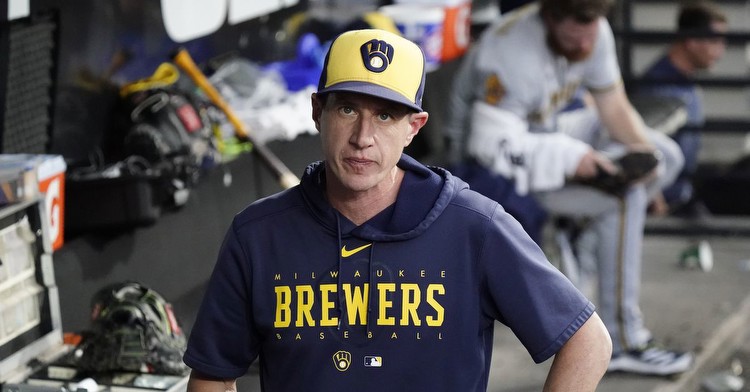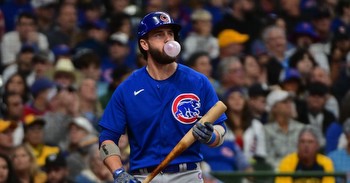Cubs BCB After Dark: The Cubs shock the baseball world

Welcome back to BCB After Dark: the swingingest set for night owls, early risers, new parents and Cubs fans abroad. It’s our first official show of the offseason, and we’re glad that you are sticking around after the baseball ends. Come on in out of the autumn chill. There’s no cover charge this evening. We’ve still got a couple of good tables available. Bring your own beverage.
BCB After Dark is the place for you to talk baseball, music, movies, or anything else you need to get off your chest, as long as it is within the rules of the site. The late-nighters are encouraged to get the party started, but everyone else is invited to join in as you wake up the next morning and into the afternoon.
Last time I asked you how deep the Cubs would get into the free agent starting pitching market. The vote was very evenly divided among the top two categories as “Minor” (defined by a total contract of between $20 to $50 million) edged out “Major” (over $50 million) by 35 percent to 34 percent. “Budget” got 18 percent and none/trades got 13 percent.
Here’s the part where I write about music and movies. You’re free to skip ahead to the Cubs part if you’d like. You won’t hurt my feelings.
We’re all sitting around with our jaws on the floor after the Cubs’ news of today and I’ll talk more about that in the third section. But all I could think of was “ain’t that a kick in the head?” So here’s Dean Martin singing “Ain’t That a Kick in the Head?” I mean, the song is stuck in my head so it might as well be stuck in yours. And it serves as a good soundtrack for today’s news.
This is from the original Ocean’s 11 movie.
I finally watched a movie I’ve been wanted to see for a while, 1947’s Forever Amber, starring Linda Darnell and Cornel Wilde and directed by Otto Preminger. I’ve been wanting to see this movie not because of my love of epic, period costume romances because I don’t actually love epic, period costume romances. No, I’ve wanted to watch this film because of the story behind it and how despite being the film adaptation of the best-selling book of the 1940s, the novel and the film are mostly forgotten today. (Although the book does still have its fans, especially among the romance novel set.)
The reason why I’ve been so curious about Forever Amber is that a lot films and radio shows of the period would use the book as a punchline or a throwaway joke. I’d never heard of it, but the book was famous enough that no one felt the need to explain the joke. So me, watching and reading almost eighty years later, had no idea what the point of these jokes were. Luckily, we have the internet these days and I was able to look it up. And I found the story of the book and the film to be fascinating.
Kathleen Winsor was a student at Cal-Berkeley in the 1930s, where she met and married All-America football player Bob Herwig. Herwig was a fourth-round pick of the Chicago Cardinals in 1938, although he decided against pursuing a professional football career. Eventually Herwig, like most men of his generation, ended up in the military and went off to fight World War II, leaving Kathleen home by herself with a lot of time on her hands.
At Cal, Herwig had written his senior thesis on Restoration England and Winsor had helped him finish it. (I’m going to assume that she typed it up, as was common at that time. She may have done more.) Winsor became fascinated by the topic of Restoration England (the period of Charles II after the Civil War and the end of the Commonwealth in the 1660s) and by her own account, read 356 books on the subject. That lead to her writing the story of Amber St. Clare, an orphan foundling who climbs her way up from the bottom to the pinnacle of English society. To be crude about it, Amber sleeps her way to the top, eventually becoming the mistress of Charles II himself. All the while, her and her true love, Lord Bruce Carlton, are constantly kept apart by various plot devices.
The comparisons of Forever Amber to Gone With the Wind were immediately obvious to people who read both books. Both featured plucky heroines who lived in a bygone era who were forced to rely on their wits and their resourcefulness to survive. The difference, of course, is that Amber was used sex to advance herself more often, with more partners and more willingly than Scarlett O’Hara ever did. And what really scandalized American society about Forever Amber was that she was unapologetic about all of it. Amber St. Clare felt no shame about her “scandalous” ways. Nor was she ever punished for it. Yes, Amber had reverses in both the novel and the film, but she ends up at the top of English society and likes it. (Although in the book, she does get tricked out of it in the end. But this seems like just another one of the temporary reversals that she had earlier in the novel. It also appears to set up a sequel that Winsor planned but never wrote.)
As you might imagine, Forever Amber got decried as a dirty book, unfit for polite society. It was banned as pornographic in 14 states and all of Australia. You couldn’t send it through the US mail under the laws intended to ban indecent material. In the court case about its legality in Massachusetts, the State Attorney General noted that Forever Amber contained:
70 references to sexual intercourse; 39 to illegitimate pregnancies; 7 to abortions; 10 descriptions of women undressing, dressing or bathing in the presence of men; 5 references to incest; 13 references ridiculing marriage; and 49 miscellaneous objectionable passages.
The publisher won the case as the State Supreme Court ruled that was an accurate portrayal of Restoration England.
All this banning was great publicity, and the book flew off the shelves. Even in places where it was banned, people found a way to get their hands on it. It was a sensation.
Obviously you can see where the jokes came from—the idea that there was this scandalous book that everyone had read but pretended they hadn’t. There was an episode of the Dennis Day radio program with a costume party where everyone went as their favorite literary character. Day went as Amber, and the very mention of that caused the audience to roar in laughter. (One supposes that joke works better on the radio where Day’s appearance is left to the audience’s imagination.) Then guests at the party unconvincingly try to pretend that they weren’t familiar with the book.
Reading modern takes on the book, the word “tame” invariably comes in. Yes, there are lots of references to sex, but they aren’t detailed descriptions. Mostly, they are just that, acknowledgements that Amber (or other women) got naked, had sex or had abortions. What scandalized American society wasn’t the prose. It was the idea that Amber could lead this immoral life, not feel guilty about it and not be punished for it. In fact, the reader was supposed to root for and identify with this plucky outsider to high society. Many modern critics think Forever Amber is a feminist classic.
And lots and lots of women (and even some men) of the 1940s did identify with Amber. Despite all the bans, or maybe because of them, Forever Amber became the best-selling book of the decade. Kathleen Winsor became a celebrity. She divorced Herwig right after he got back from the war and married famous bandleader Artie Shaw. Because of the book’s fame and notoriety, Hollywood just had to make a movie about it, like they had with Gone With the Wind in the 1930s.
You can see the problem with adapting Forever Amber to the screen. The Production Office condemned the book as immoral even before the film rights had been sold to anyone. This wasn’t a matter of convincing the Hays people that “Frankly Scarlett, I don’t give a damn” should be allowed in the script. This was trying to convince them to approve a film based on a book that violated almost every “no” in the Code.
But the comparisons to Gone With the Wind were too strong to not try. Like GWTW a decade earlier, a highly-publicized search was launched for an actress to play Amber. They were hoping to find someone like Vivien Leigh, a then-little-known English actress who would be catapulted to stardom by the part. After several months, they finally announced their choice to play Amber St. Clare: unknown Irish-Welsh actress Peggy Cummins.
You may note that I mentioned that Forever Amber stars American actress Linda Darnell and not Cummins. That’s because the production was plagued with problems from the beginning. Cummins wasn’t used to the demanding schedule such a epic shoot required and collapsed from exhaustion at least once. (Hot stage lights and heavy costumes didn’t help.) Cummins got sick and needed time off. The producers and 20th Century Fox also didn’t like what they were seeing from the dailies. Cummins seemed fine in the early scenes as the young Amber, but this movie took place over the course of more than a decade and Cummins seemed too young and fresh-faced to convincingly portray the older and more-wisened Amber. After 39 days, the producers made the difficult decision to start over, fire Cummins and replace her with the more-experienced Linda Darnell. Darnell exchanged her trademark raven tresses for a amber-red wig. Director John M. Stahl was also canned and replaced with Preminger.
Cummins went on to star in Gun Crazy, a much better movie with a much smaller budget. Not exactly a happy ending, but she did eventually return to the UK and had a decent career in the film industry there.
Obviously the script for Forever Amber bowdlerized the novel. Amber’s lovers are cut down from a few dozen to just five. (Admittedly, a film today would have to do some of that as the novel is 972 pages long.) The love scenes in the film became no different that any other love scene at the time—the man and the woman passionately kiss and then the screen jumps to the next scene. There are no references to abortion and Amber’s role as a mother to her illegitimate son (by Lord Carlton, her true love) gains added emphasis. Yes, she still sleeps her way up and down English society, but she seems much more miserable doing so. And while the novel has an open ending that left the possibility of a sequel, the film has a sadder ending that shows that Amber paid a cost for her immorality. (Although it’s not a tragic one—Amber just ends up sad and miserable.) They also added a few lines about Amber’s wickedness and a prologue that stated that “The wages of sin is death.”
Forever Amber was finally released in October of 1947 and it was a big hit. It was no Gone With the Wind (still arguably the biggest box office of all time adjusted for inflation) but the millions of people who read the book turned out to see the film. It was also, despite the changes, condemned by the Legion of Decency and subject to Catholic-organized boycotts, which only increased the publicity for the film and drove the box office even more.
But unlike Gone With the Wind, Forever Amber didn’t have much of an afterlife. It was a hit and then pretty much promptly forgotten after that—as evidenced by the fact that I’m betting most of you reading this had never heard of it before right now. I know I hadn’t until I started noticing references to the book in movies and radio shows of the period.
So is Forever Amber, the film, as good as the story behind it? Eh, it’s OK. I’m going to admit that I’m not the target audience for Forever Amber, but much of the popularity of the book was because of an unapologetic woman who flouted every bit of contemporary morality to get what she wanted. They weren’t allowed to show that in a Hollywood film in the Code era, and it robs the character of Amber of most of her power. Amber’s character isn’t one to be admired, but more one that we’re supposed to “tsk, tsk” about.
Still there are some good things about Forever Amber, mostly in the world-building of Restoration England. The budget on this film was a then-record for 20th-Century Fox and it shows. The costumes itself are worthy of watching the film, but the set designs and the way they recreate 17th Century England are just fantastic. The section of the movie with the Great Fire of London is terrific, with the conflagration rivaling the burning of Atlanta in GWTW. The plague scenes are extremely well-done as well, and for those of you who are only familiar with the cry “Bring out your dead” from Monty Python and the Holy Grail, Forever Amber did that bit first. (Of course, Forever Amber doesn’t have any bodies disputing their deaths.)
Forever Amber isn’t a bad film and it is very visually interesting. If you are a fan of epic historical romances, it is certainly worth seeing. But for me, what was really interesting about Forever Amber is the story behind it more than the film itself.
I believe this is a fan-made trailer for Forever Amber. It’s a little long, but you get a really good sense of the 80-grade costuming and hair for the movie. The entire movie appears to have been uploaded to YouTube a couple of times if you are interested, which just goes to show how far the film has fallen into obscurity. Can you imagine Gone With the Wind being uploaded to YouTube without a takedown notice in an hour?
Welcome back to everyone who skips the music and movies.
Wow. What a day. I was not expecting the Cubs to fire David Ross and hire Craig Counsell. I’ve certainly been critical of some of Ross’ decision-making and I ran a poll in this space back in May or June asking whether Ross should get canned. But I figured the second-half turnaround was enough to keep Ross’ job safe. Of course, the late-season collapse probably put Ross back in the danger zone, but I wasn’t thinking about that.
But this was more about Counsell than it was about Ross. From this article by Sahadev Sharma, (sub. req.) team president Jed Hoyer had identified Counsell as the best manager in baseball. When he became available after his contract ran out, he made contact with Counsell and quickly discovered that there was mutual interest. The entire thing was done in secret as if Counsell did not end up coming to Chicago, Ross was coming back. It would have been awkward if it came out that Hoyer had been talking to Counsell.
Obviously this all has echoes of the moment when the Cubs hired Joe Maddon despite still employing Rick Renteria. We can hope that turns out as well.
Is Craig Counsell the best manager in baseball? I’ve been watching baseball for decades and I’ve come to the conclusion that no one really knows how to evaluate a great manager, nor do we know how many wins a manager is worth. It’s much easier to identify a bad manager than a good one. But if Craig Counsell causes the Cubs win one or two more games a year, then $8 million a year for five years is a freaking bargain. That’s the price of a solid back-end starter on the free agent market. Just last month, Bob Nightengale wrote that MLB managers were grossly underpaid compared to their worth. That article points out that are ten NCAA head coaches who make more money that Braves manager Brian Snitker, who has done nothing but win since he took over Atlanta. Snitker could leave for Vanderbilt or LSU and get a big raise.
So maybe this is a new market inefficiency that Hoyer has decided to exploit. Manager salaries don’t count towards the luxury tax, after all. And honestly, if Ronald Acuña Jr. fell into the Cubs lap, I don’t think anyone would say “But Seiya Suzuki doesn’t deserve to lose his job as the Cubs’ right fielder.” As good as Suzuki is, Acuña is better. You make that move and don’t worry about Suzuki being out of a job. I don’t see how the managerial position is any different. Of course, it’s harder to evaluate who is the better manager than who is the better right fielder, so that complicates things.
This is a sign that the Cubs are looking to spend money this offseason. You don’t go out and make Craig Counsell the highest-paid manager in baseball history and then turn around and cut payroll. This doesn’t mean the Cubs are going to recreate what the Mets tried to do last year and blow through the luxury tax by over $100 million dollars. But Counsell came here because he wants to go to a team that spends money to win. (That Wrigley is a reasonable drive from his house on Lake Michigan probably recommended Chicago to him over New York as well, but he could have stayed in Milwaukee and had an easier drive.)
So while all of this makes sense, I’m still shocked. I did not see this coming. And in Al’s article announcing the move, he seemed shocked as well. So shocked, in fact, that he did not put in a poll asking you what you thought of the move.
So I’m asking you here. What is your opinion of the decision to hire Craig Counsell and fire David Ross?
Poll
Hiring Craig Counsell and firing David Ross?
Thank you for stopping by, where we are never in the offseason. If you checked anything, let us get that for you now. Recycle any cans or bottles. Get home safely. Tip your waitstaff. And join us again tomorrow night for more BCB After Dark.




































